Hands on Microsoft HoloLens review: has Microsoft's augmented-reality headset been worth the wait?
We spray paint floating widgets with a replicant ballerina to find out
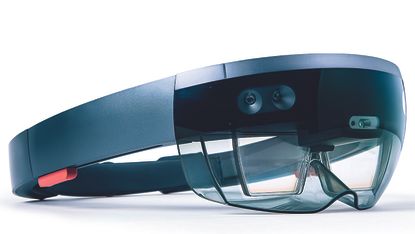
Why you can trust T3

So, I'm in a room swarming with rats, with a rather unsavoury character who's pointing a gun at a child's head. Lovely.
Now I'm in a Volvo showroom. But it's really exciting!
And now I'm constructing and spray-painting floating widgets, while a Blade Runner-esque, replicant ballerina pirouettes in the background. Although, to be honest, that could just be my flat on any given day.
Welcome to the Microsoft HoloLens. This pair of augmented-reality (AR) 'goggles' is actually somewhere between a cycling helmet and a futuristic welding mask. You're probably already familiar with virtual reality (VR) from the likes of the Oculus Rift, the HTC Vive and the Samsung Gear VR; and with the concept of AR from Pokémon Go.
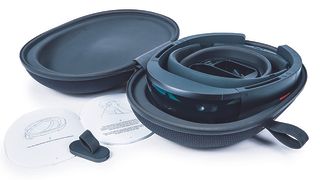
Where VR replaces your reality with another one, AR layers graphics ('holograms', Microsoft calls them) over your actual surroundings, so you can see monsters in your garden without needing recourse to LSD.
Unlike the Rift or the Vive, the HoloLens is totally wireless. That's because, as well as the screens that paint the holograms over your surroundings, this bulbous RoboCop helmet also houses all the necessary processing power and cameras to enable it to 'see'.
For this reason, and the fact that you can still view the room you're in, you can walk around freely while wearing the HoloLens. Speakers add surround sound for a more immersive experience.
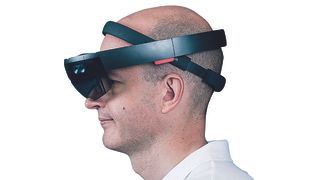
Sophisticated software maps your surroundings, then plonks the holograms into available spaces and onto surfaces - not just walls and floors, but also furnishings in your gracious home – tables, for instance.
So, in the app with the unpleasant, gun-wielding chap, you must look for clues as to what's going on. But they're not just pinned to the wall, they're also sat on whatever furniture happens to be in your room, or even under it.
Similarly, in the virtual Volvo showroom – the real-life version of which I travelled to Microsoft's base near Seattle to see – cars sat in miniature on table tops so that I could scroll through the colour and trim options, and could then be viewed and walked around, in full size, on a stage. I couldn't kick the tyres, though.
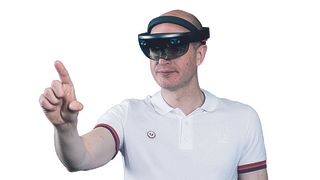
Now, this is all very exciting, but the HoloLens is only available to developers at the moment, and in some respects it doesn't feel like a finished product.
The most important thing to understand about this helmet is hard to convey, but bear with me. What you see is NOT simply the world with holograms added to it. No, what you see is the world, with holograms filling a 'screen' hanging a few inches in front of your nose.
The issue with this is that if you get too close to a large hologram, the edges of it will begin to shear off. The best way I can describe it is that it's like looking at VR but through a letterbox.
In the Volvo showroom, everything easily controlled so that I was always the right distance from the virtual objects to minimise this effect. A set had been constructed and I was guided around it.
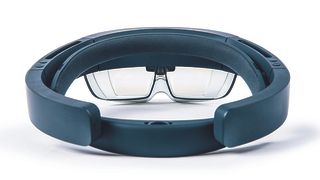
However, viewed 'in the wild', the HoloLens is a very different experience. Human characters in games have an impressive solidity but no legs – until you look down, at which point their legs come into view, but you can no longer see their heads. It's a kind of tunnel vision.
Control of menus and virtual objects comes via a mix of voice control and gestures, although there's also a handheld mouse if that's 2 Future 4 U.
The most common gesture is the 'air tap', where you bring your ring finger down to meet your thumb, like you're crushing the head of someone in the distance. You can also rotate objects by, yes, rotating your hand, and exit whatever you're doing with a dismissive opening of your fist, like you're releasing a butterfly back into the wild.

This gesture control all sounds very Minority Report, right? Well, let me tell you a funny story about Minority Report... After 'cut' was called on each scene in that film's time-police incident room, Tom Cruise had to go and have a massage and a bit of a lie-down. Why? Because his arms were tired from all the gesturing. At the time, he was one of the fittest guys in the world.
Now, by no means am I in terrible shape, but I was f**king knackered after doing gestures for a few minutes, for this article. Because of this, and its visual limitations, the HoloLens strikes me as more or less useless as a gaming device – and Microsoft isn't going out of its way to push it as one.

However, as a tool for more serious matters – education, industrial training, electrical and plumbing repairs, and surgery – and also for things like 'experiential marketing', the HoloLens could one day be an invaluable tool. Despite its obvious flaws, I really like it.
T3 gives massive thanks and 'mad props' to all at BBH for their invaluable assistance in putting this together.
Sign up to the T3 newsletter for smarter living straight to your inbox
Get all the latest news, reviews, deals and buying guides on gorgeous tech, home and active products from the T3 experts
Duncan is the former lifestyle editor of T3 and has been writing about tech for almost 15 years. He has covered everything from smartphones to headphones, TV to AC and air fryers to the movies of James Bond and obscure anime. His current brief is everything to do with the home and kitchen, which is good because he is an excellent cook, if he says so himself. He also covers cycling and ebikes – like over-using italics, this is another passion of his. In his long and varied lifestyle-tech career he is one of the few people to have been a fitness editor despite being unfit and a cars editor for not one but two websites, despite being unable to drive. He also has about 400 vacuum cleaners, and is possibly the UK's leading expert on cordless vacuum cleaners, despite being decidedly messy. A cricket fan for over 30 years, he also recently become T3's cricket editor, writing about how to stream obscure T20 tournaments, and turning out some typically no-nonsense opinions on the world's top teams and players.
Before T3, Duncan was a music and film reviewer, worked for a magazine about gambling that employed a surprisingly large number of convicted criminals, and then a magazine called Bizarre that was essentially like a cross between Reddit and DeviantArt, before the invention of the internet. There was also a lengthy period where he essentially wrote all of T3 magazine every month for about 3 years.
A broadcaster, raconteur and public speaker, Duncan used to be on telly loads, but an unfortunate incident put a stop to that, so he now largely contents himself with telling people, "I used to be on the TV, you know."
-
 Netflix just gave every iPhone and Android user an early Christmas present
Netflix just gave every iPhone and Android user an early Christmas presentLong-awaited, exclusive title now available on Netflix for free
By Rik Henderson Published
-
 OMEGA launches new James Bond-inspired Seamaster Diver in bronze gold
OMEGA launches new James Bond-inspired Seamaster Diver in bronze goldOMEGA’s new Seamaster Diver 300M is a Bond fan’s dream
By Bethan Girdler-Maslen Published
-
 Anya Taylor-Joy stuns in trailer for Apple TV+'s hellish sci-fi love story
Anya Taylor-Joy stuns in trailer for Apple TV+'s hellish sci-fi love storyThe Gorge has one hell of a twist
By Max Freeman-Mills Published